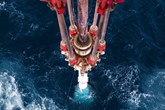What lies beneath: DNV GL helps industry get ahead in offshore leak detection
Published by Louise Mulhall,
Editorial Assistant
Oilfield Technology,
It is a necessity for oil and gas operators to have a reliable leak detection system that is capable of detecting leaks within an acceptable level of certainty and which meets regulatory requirements. Hydrocarbon leak detection systems are a requirement on both the Norwegian and UK Continental Shelves, and it is becoming commonplace for authorities around the world to demand systems be installed for new field developments.
The Recommended Practice (DNVGL-RP-F302) is based on the findings of a DNV GL led joint industry project (JIP) completed in 2015 with 19 companies, including Eni, Lundin, Petrobras and FMC technologies, and industry regulators as observers. It covers all the lifecycle phases of a field development for successful planning, design, integration and operation of leak detection technology in offshore hydrocarbon productions. A thorough process has been defined where the key stages are functional requirements, design requirements, technology selection, detailed design, function testing and operation.
“Until now, there has been no guidance for operators covering selection and operation of offshore leak detection systems for an entire field, including both subsea and surface. Having an optimised leak detection system provides key decision support in limiting the impact of an oil spill, reducing response time and reducing costs from recovery operations,” says Jock Brown, Head of Section Environmental Technology Advisory, DNV GL – Oil & Gas. This RP is based on industry experience and provides a robust approach that will support the industry in reducing its footprint and minimising environmental risks from their operations,” adds Brown.
The RP defines reasonable specifications, requirements, and guidance on how different technologies can be integrated into a system that is practical for the end user.
The RP replaces the DNV-RP-F302 Selection and Use of Subsea Leak Detection Systems (2010).
Adapted from a press release by Louise Mulhall
Read the article online at: https://www.oilfieldtechnology.com/offshore-and-subsea/11042016/what-lies-beneath-dnv-gl-helps-industry-get-ahead-in-offshore-leak-detection/
You might also like
Weatherford awarded Managed Pressure Drilling contract for Woodside Energy’s Trion deepwater development
The multi-year contract includes MPD services for an initial 8 wells with the potential to expand to 24 wells. The award reinforces Weatherford’s market leadership in high-performance MPD and expands its presence in Mexico’s offshore energy sector.

